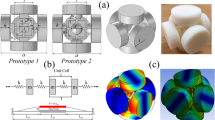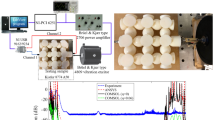Abstract
Purpose
To date, endowing the honeycomb metamaterial with tunable low frequency broad bandgaps is still a challenging task. This work provides a new strategy for the design of metamaterial for low frequency and broad bandgaps in the fields of vibration and noise reduction.
Methods
In this work, a novel multiple re-entrant star-shaped honeycomb (MRSSH) with tunable negative Poisson’s ratio (NPR) and bandgaps is proposed. The band structures are obtained through scanning the Bloch wave vector along the IBZ boundary. Formation mechanics of the bandgaps, influences of geometry parameters on the bandgap distribution and effective bandgap width are also investigated. In addition, the external uniaxial and equibiaxial strains are introduced to the MRSSH in order to explore tunability of bandgaps.
Results
The results show that the proposed MRSSH could achieve low frequency broad bandgaps by designing the geometry parameters rationally. By introducing external deformation, the bandgaps are narrowed or broadened, which shows the tunability of bandgaps. To verify the correctness of calculated bandgaps, the vibration transmission of the supercell structure with the core of finite-sized MRSSH is explored.
Conclusion
The proposed MRSSH can obtain low frequency broad bandgaps by changing the geometry parameters. Research of this paper provides a new method for design of acoustic metamaterials for low frequency vibration and noise reduction.











Similar content being viewed by others
References
Vos R, Barrett R (2010) Pressure adaptive honeycomb: a new adaptive structure for aerospace applications. Proceedings of SPIE-The International Society for Optical Engineering
Hu LL, Wu ZJ, Fu MH (2018) Mechanical behavior of anti-trichiral honeycombs under lateral crushing. Int J Mech Sci 140:537–546
Wang YB, Liu HT, Zhang ZY (2020) Rotation spring: Rotation symmetric compression-torsion conversion structure with high space utilization. Compos Struct 245:11234
Wang L, Liu HT (2020) 3D compression–torsion cubic mechanical metamaterial with double inclined rods. Extreme Mech Lett 37:100706
Yao SG, Xiao XL, Xu P, Qu QY, Che QW (2018) The impact performance of honeycomb-filled structures under eccentric loading for subway vehicles. Thin Wall Struct 123:360–370
Crupi V, Epasto G, Guglielmino E (2013) Comparison of aluminium sandwiches for lightweight ship structures: honeycomb vs. foam. Mar Struct 30:74–96
Wang L, An MR, Liu HT (2020) Compression spin bio-inspired arm: a conceptual model based on compression–torsion cubic mechanical metamaterials with variable cross-section. Extreme Mech Lett 41:101069
Torquato S, Gibiansky LV, Silva MJ, Gibson LJ (1998) Effective mechanical and transport properties of cellular solids. Int J Mech Sci 40:71–82
Qiao PZ, Fan W, Davalos JF, Zou GP (2008) Optimization of transverse shear moduli for composite honeycomb cores. Compos Struct 85:265–274
Theocaris PS, Stavroulakisp GE, Panagiotopoulos D (1997) Negative Poisson’s ratios in composites with star-shaped inclusions: a numerical homogenization approach. Arch Appl Mech 67:274–286
Reis FD, Ganghoffer JF (2012) Equivalent mechanical properties of auxetic lattices from discrete homogenization. Comp Mater Sci 51(1):314–321
Sun YT, Pugno N (2013) In plane stiffness of multifunctional hierarchical honeycombs with negative Poisson’s ratio sub-structures. Compos Struct 106:681–689
Scarpa F, Tomlin PJ (2000) On the transverse shear modulus of negative Poisson’s ratio honeycomb structures. Fatigue Eng Mater Struct 23:717–720
Wu QQ, Gao Y, Wei XY, Mousanezhad D, Ma L, Vaziri A, Xiong J (2018) Mechanical properties and failure mechanisms of sandwich panels with ultra-lightweight three-dimensional hierarchical lattice cores. Int J Mech Sci 132–133:171–187
Xue YY, Wang W, Han FS (2019) Enhanced compressive mechanical properties of aluminum based auxetic lattice structures filled with polymers. Compos Part B 171:183–191
Carneiro VH, Puga H, Meireles J (2019) Positive, zero and negative Poisson’s ratio nonstochastic metallic cellular solids: dependence between static and dynamic mechanical properties. Compos Struct 226:111239
Zhang XW, Yang DQ (2016) Numerical and experimental studies of a light-weight auxetic cellular vibration isolation base. Shock Vib 9:1–16
Vasiliev AA, Miroshnichenko AE, Dmitriev SV (2014) Multi-field modeling of a Cosserat lattice: models, wave filtering, and boundary effects. Eur J Mech A-Solid 46:96–105
Song F, Huang GL, Hu GK (2009) Online debonding detection in honeycomb sandwich structures using multi-frequency guided waves, International Conference on Smart Materials & Nanotechnology in Engineering. International Society for Optics and Photonics
Zhu R, Liu XN, Hu GK, Sun CT, Huang GL (2014) Negative refraction of elastic waves at the deep-subwavelength scale in a single-phase metamaterial. Nat Commun 5:5510
Oh JH, Seung HM, Kim YY (2017) Doubly negative isotropic elastic metamaterial for sub-wavelength focusing: design and realization. J Sound Vib 410:169–186
Gajic R, Meisels R, Kuchar F, Hingerl K (2006) All-angle left-handed negative refraction in Kagome and honeycomb lattice photonic crystals. Phys Rev B 73(16):165310
Maldovan M (2013) Sound and heat revolutions in phononics. Nature 503(7475):209–217
Phani AS, Woodhouse J, Fleck NA (2006) Wave propagation in two-dimensional periodic lattices. J Acoust Soc Am 119(4):1995–2005
Wang YF, Wang YS, Zhang CZ (2014) Bandgaps and directional propagation of elastic waves in 2D square zigzag lattice structures. J Phys D 47(48):485102
Chen YY, Wang LF (2016) Harnessing structural hierarchy to design stiff and lightweight phononic crystals. Extreme Mech Lett 9:91–96
Tee KF, Spadoni A, Scarpa F, Ruzzene M (2010) Wave Propagation in auxetic tetrachiral honeycombs. J Vib Acoust 132(3):031007
Mukherjee S, Scarpa F, Gopalakrishnan S (2016) Phononic band gap design in honeycomb lattice with combinations of auxetic and conventional core. Smart Mater Struct 25(5):054011
Meng J, Deng Z, Zhang K, Xu X, Wen F (2015) Band gap analysis of star-shaped honeycombs with varied Poisson’s ratio. Smart Mater Struct 24:095011
Chen M, Xu WS, Liu Y, Yan K, Jiang H, Wang YR (2018) Band gap and double-negative properties of a star-structured sonic metamaterial. Appl Acoust 139:235–242
Kumar N, Pal S (2019) Low frequency and wide band gap metamaterial with divergent shaped star units: numerical and experimental investigations. Appl Phys Lett 115(25):254101
Bertoldi K, Boyce MC (2008) Mechanically triggered transformations of phononic band gaps in periodic elastomeric structures. Phys Rev B 77:052105
Shim J, Wang P, Bertoldi K (2015) Harnessing instability-induced pattern transformation to design tunable phononic crystals. Int J Solids Struct 58:52–61
Fei X, Jin L, Zhang XJ, Lu MH (2020) Three-dimensional anti-chiral auxetic metamaterial with tunable phononic bandgap. Appl Phys Lett 116(2):021902
Chen YY, Li TT, Scarpa F, Wang LF (2017) Lattice metamaterials with mechanically tunable Poisson’s ratio for vibration control. Phys Rev Appl 7(2):024012
Jiang H, Zhang MG, Liu Y, Pei DL, Wang YR (2020) Band gaps and vibration isolation of a three-dimensional metamaterial with a star structure. Materials 13(17):3812
Chang SY, Chen CD, Yeh JY, Chen LW (2019) Elastic wave propagation of two-dimensional metamaterials composed of auxetic star-shaped honeycomb structures. Curr Comput-Aided Drug Des 9(3):121
D’Alessandro L, Belloni E, Ardito R, Corigliano A, Braghin F (2016) Modeling and experimental verification of an ultra-wide bandgap in 3D phononic crystal. Appl Phys Lett 109:221907
Wang P, Shim JM, Bertoldi K (2013) Effects of geometric and material nonlinearities on tunable band gaps and low-frequency directionality of phononic crystals. Phys Rev B 88(1):2466–2472
Ning SW, Yang FY, Luo CC, Liu ZL, Zhuang Z (2020) Low-frequency tunable locally resonant band gaps in acoustic metamaterials through large deformation. Extreme Mech Lett 35:100623
Acknowledgements
This work was supported by the National Natural Science Foundation of China (11702079).
Author information
Authors and Affiliations
Corresponding author
Ethics declarations
Conflict of interest
The authors declared no potential conflicts of interest with respect to the research, authorship, and/or publication of this article.
Additional information
Publisher's Note
Springer Nature remains neutral with regard to jurisdictional claims in published maps and institutional affiliations.
Rights and permissions
About this article
Cite this article
Ren, F., Liu, H. Strain Induced Low Frequency Broad Bandgap Tuning of the Multiple Re-entrant Star-Shaped Honeycomb with Negative Poisson’s Ratio. J. Vib. Eng. Technol. 10, 3157–3168 (2022). https://doi.org/10.1007/s42417-022-00547-3
Received:
Revised:
Accepted:
Published:
Issue Date:
DOI: https://doi.org/10.1007/s42417-022-00547-3




